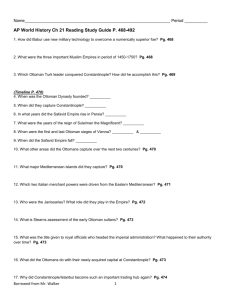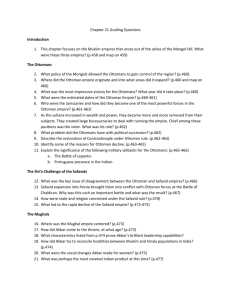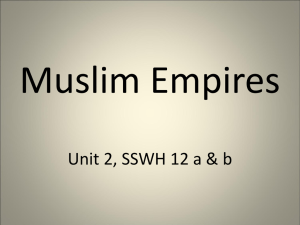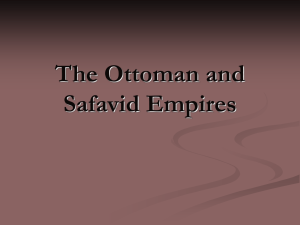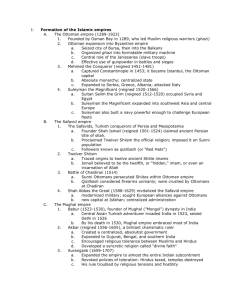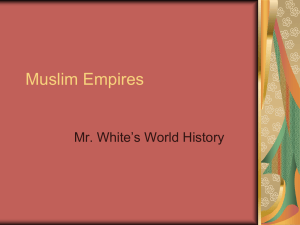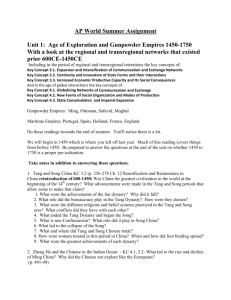Chapter 20: The Muslim Empires Quiz 1) The Ottomans conquered
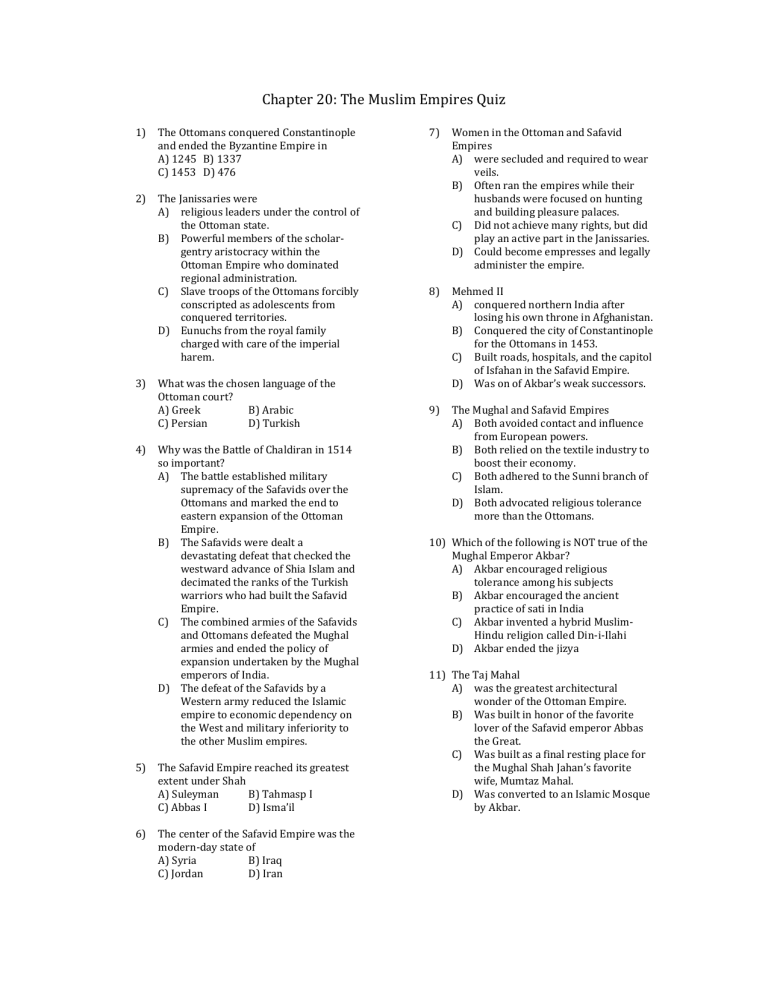
Chapter 20: The Muslim Empires Quiz
1) The Ottomans conquered Constantinople and ended the Byzantine Empire in
A) 1245 B) 1337
C) 1453 D) 476
2) The Janissaries were
A) religious leaders under the control of the Ottoman state.
B) Powerful members of the scholargentry aristocracy within the
Ottoman Empire who dominated regional administration.
C) Slave troops of the Ottomans forcibly conscripted as adolescents from conquered territories.
D) Eunuchs from the royal family charged with care of the imperial harem.
3) What was the chosen language of the
Ottoman court?
A) Greek
C) Persian
B) Arabic
D) Turkish
4) Why was the Battle of Chaldiran in 1514 so important?
A) The battle established military supremacy of the Safavids over the
Ottomans and marked the end to eastern expansion of the Ottoman
Empire.
B) The Safavids were dealt a devastating defeat that checked the westward advance of Shia Islam and decimated the ranks of the Turkish warriors who had built the Safavid
Empire.
C) The combined armies of the Safavids and Ottomans defeated the Mughal armies and ended the policy of expansion undertaken by the Mughal emperors of India.
D) The defeat of the Safavids by a
Western army reduced the Islamic empire to economic dependency on the West and military inferiority to the other Muslim empires.
5) The Safavid Empire reached its greatest extent under Shah
A) Suleyman
C) Abbas I
B) Tahmasp I
D) Isma’il
6) The center of the Safavid Empire was the modern-day state of
A) Syria
C) Jordan
B) Iraq
D) Iran
7) Women in the Ottoman and Safavid
Empires
A) were secluded and required to wear veils.
B) Often ran the empires while their husbands were focused on hunting and building pleasure palaces.
C) Did not achieve many rights, but did play an active part in the Janissaries.
D) Could become empresses and legally administer the empire.
8) Mehmed II
A) conquered northern India after losing his own throne in Afghanistan.
B) Conquered the city of Constantinople for the Ottomans in 1453.
C) Built roads, hospitals, and the capitol of Isfahan in the Safavid Empire.
D) Was on of Akbar’s weak successors.
9) The Mughal and Safavid Empires
A) Both avoided contact and influence from European powers.
B) Both relied on the textile industry to boost their economy.
C) Both adhered to the Sunni branch of
Islam.
D) Both advocated religious tolerance more than the Ottomans.
10) Which of the following is NOT true of the
Mughal Emperor Akbar?
A) Akbar encouraged religious tolerance among his subjects
B) Akbar encouraged the ancient practice of sati in India
C) Akbar invented a hybrid Muslim-
Hindu religion called Din-i-Ilahi
D) Akbar ended the jizya
11) The Taj Mahal
A) was the greatest architectural wonder of the Ottoman Empire.
B) Was built in honor of the favorite lover of the Safavid emperor Abbas the Great.
C) Was built as a final resting place for the Mughal Shah Jahan’s favorite wife, Mumtaz Mahal.
D) Was converted to an Islamic Mosque by Akbar.
12) Akbar sought to improve women’s status in India by
A) banning sati.
B) Discouraging child marriages.
C) Encouraging widows to remarry.
D) All of the above.
13) Which of the following is true about the
Ottoman Empire?
A) The Ottomans official language was
Persian
B) The Ottomans practiced Shia Islam
C) The Ottomans were very powerful and rivaled Europe for dominance in the Mediterranean Sea and southern
Europe.
D) The Ottomans were very effective in compromising and making concessions to their Hindu subjects in India
14) What was a similarity in the Ottoman and
Safavid rise to power?
A) In both cases, the retreat of the
Mongols from the Middle East allowed both empires to rise and gain power.
B) Isma’il and the Red Heads founded both dynasties.
C) The desire to spread the Sunni branch of Islam caused both empires to expand and conquer territory and convert people.
D) Both empires rose to power at roughly the same time, and often worked together to conquer their enemies.
15) What is a similarity shared by the
Ottomans, Safavids, and Mughals?
A) All three empires shared borders with Europe and constantly warred with Christian kingdoms.
B) Though all three empires slowly declined after the 1720s, all three lasted into the early 20 th century.
C) All three empires practiced some form of Islam.
D) All three empires were able to effectively implement religious tolerance laws.
16) Which of the following was a common factor in the decline of all three of the
Muslim Empires?
A) A series of weak and/or ineffective rulers
B) Inability to adopt new weapon technology
C) The spread of Christianity within the empires caused instability
D) Invasions by the Chinese
17) A factor that led to the eventual decline of both the Ottoman and Mughal Empires was
A) clashes with Spanish conquistadors.
B) Imperial overreach.
C) Religious intolerance led to revolts among Christians and Jews.
D) The Christian slaves that the empires used finally revolted against the imperial government in the mid-
1800s.
18) The Ottomans
A) were Sunni Muslims, but discriminated against “peoples of the book” (Christians and Jews).
B) Were Shia Muslims, but discriminated against “peoples of the book” (Christians and Jews).
C) Were Sunni Muslims, but tolerated
“peoples of the book” (Christians and
Jews).
D) Were Shia Muslims, but tolerated
“peoples of the book” (Christians and
Jews).
19) Though status for women was low in all three of the Muslim Empires, women experienced the most amount of freedom in
A) The Ottoman Empire
B) Safavid Empire
C) Mughal Empire
D) I didn’t study or listen in class
20) The Ottoman and Mughal Empires both
A) used gunpowder effectively in order to expand and conquer enemies.
B) Practiced Shia Islam.
C) Allied with European powers in order to protect their territories from the Safavids.
D) Had weaker rulers than the Safavid
Empire.
